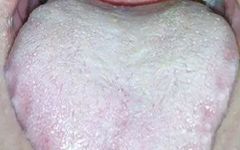Tongue Appearance 1: Thick White Coating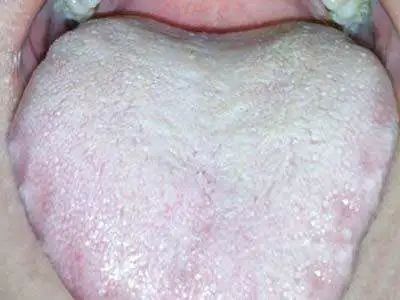 If the tongue coating is thick and white, it indicates a significant presence of phlegm-dampness in the body.A white tongue coating suggests internal cold, whether from consuming cold foods or exposure to cold environments. Nowadays, many people have a white coating due to eating refrigerated fruits and vegetables and frequently drinking cold beverages.Additionally, in daily life, a swollen tongue with a thick white coating is often seen in individuals who are overweight or have digestive issues leading to edema and an accumulation of phlegm-dampness.Expert Recommendation:Patients with a white tongue coating should avoid cold and cool foods to reduce irritation to the stomach. Furthermore, those with a thick white coating and obesity should moderate their diet, focusing on fresh vegetables, fruits, and high-fiber foods. Herbs like Shan Yao (Dioscorea opposita), Yi Yi Ren (Coix lacryma-jobi), and Shan Zha (Crataegus) are effective for strengthening the spleen and transforming dampness.Tongue Appearance 2: Thick Yellowish-White Coating
If the tongue coating is thick and white, it indicates a significant presence of phlegm-dampness in the body.A white tongue coating suggests internal cold, whether from consuming cold foods or exposure to cold environments. Nowadays, many people have a white coating due to eating refrigerated fruits and vegetables and frequently drinking cold beverages.Additionally, in daily life, a swollen tongue with a thick white coating is often seen in individuals who are overweight or have digestive issues leading to edema and an accumulation of phlegm-dampness.Expert Recommendation:Patients with a white tongue coating should avoid cold and cool foods to reduce irritation to the stomach. Furthermore, those with a thick white coating and obesity should moderate their diet, focusing on fresh vegetables, fruits, and high-fiber foods. Herbs like Shan Yao (Dioscorea opposita), Yi Yi Ren (Coix lacryma-jobi), and Shan Zha (Crataegus) are effective for strengthening the spleen and transforming dampness.Tongue Appearance 2: Thick Yellowish-White Coating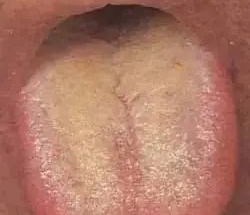 If a thick yellowish-white coating is present on the tongue, sticky and difficult to scrape off, accompanied by a sour and foul odor in the mouth, poor appetite, and dry stools, this may indicate excessive food intake or consumption of greasy foods, leading to poor digestive function or disruption, commonly referred to as food stagnation.Expert Recommendation:In such cases, it is advisable to maintain a relatively light diet. If food stagnation occurs, specific digestive herbs or foods can be taken, such as Shan Zha (Crataegus), mushrooms, and radishes. If stools are particularly dry, mild laxatives may be used.Tongue Appearance 3: Black Coating
If a thick yellowish-white coating is present on the tongue, sticky and difficult to scrape off, accompanied by a sour and foul odor in the mouth, poor appetite, and dry stools, this may indicate excessive food intake or consumption of greasy foods, leading to poor digestive function or disruption, commonly referred to as food stagnation.Expert Recommendation:In such cases, it is advisable to maintain a relatively light diet. If food stagnation occurs, specific digestive herbs or foods can be taken, such as Shan Zha (Crataegus), mushrooms, and radishes. If stools are particularly dry, mild laxatives may be used.Tongue Appearance 3: Black Coating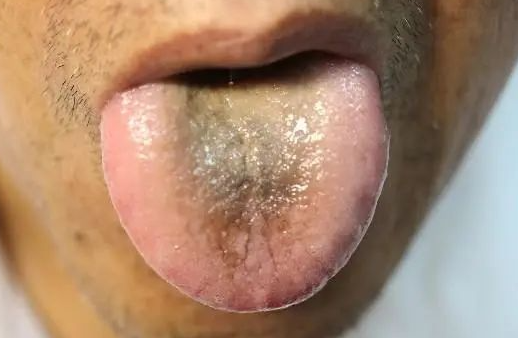 Both extreme heat and extreme cold can cause a black tongue coating, excluding cases of tongue staining.In daily life, certain medications or foods can also change the color of the tongue coating, but these do not constitute pathological coatings.Generally, stained coatings are bright and superficial, while pathological coatings are difficult to remove. This distinction is crucial to avoid misinterpreting normal coatings as pathological ones.Tongue Appearance 4: Loss of Coating
Both extreme heat and extreme cold can cause a black tongue coating, excluding cases of tongue staining.In daily life, certain medications or foods can also change the color of the tongue coating, but these do not constitute pathological coatings.Generally, stained coatings are bright and superficial, while pathological coatings are difficult to remove. This distinction is crucial to avoid misinterpreting normal coatings as pathological ones.Tongue Appearance 4: Loss of Coating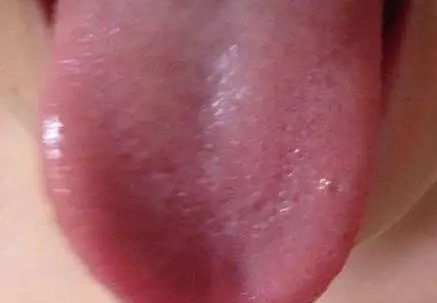 When the tongue coating is completely or partially lost during illness, it is referred to as peeling (loss) coating. Complete loss results in a smooth tongue surface, known as “Mirror Tongue”; if the coating is partially lost, leaving smooth patches with remaining coating, it is termed “Mottled Peeling Coating”.Peeling coating indicates insufficient stomach qi, depletion of stomach yin, or deficiency of both qi and blood, reflecting a state of overall weakness.Expert Recommendation:Patients with no coating should consume a light diet, avoiding overeating and the intake of raw, cold, hot, or hard-to-digest foods. They should eat more vegetables and fruits that strengthen the spleen and benefit the stomach, such as Shan Yao (Dioscorea opposita) and Yi Yi Ren (Coix lacryma-jobi), and may take herbal formulas like Jian Pi Wan (Spleen Strengthening Pill) or Sheng Mai San (Generate Pulse Powder). Regular exercise is also recommended to enhance immune function.Should Tongue Coating Be Scraped?As awareness of oral hygiene increases, various oral care products have emerged, including tongue scrapers. Many vendors claim that tongue scrapers can remove food residues from the tongue coating, freshening breath. Is this true? Does the tongue really need cleaning? What precautions should be taken when using a tongue scraper?1. Removing Tongue Coating Can Effectively Reduce Oral BacteriaHow is tongue coating formed? Tongue coating consists of shed mucosal cells, bacteria, their metabolites, and food residues. Due to the presence of numerous bacteria and food residues in the coating, bacteria decompose these residues, producing odors.From a Western medical or dental perspective, there is no evidence that tongue coating significantly correlates with overall health; however, it is certain that a large number of bacteria reside in the coating, and cleaning the tongue, including the coating, can greatly reduce the number of bacteria in the mouth.Using a tongue scraper can effectively remove food residues and bacteria from the coating, reducing the risk of periodontal disease and cavities, and can help alleviate bad breath. Therefore, if possible, using a tongue scraper occasionally is advisable.2. Improper Use of Tongue Scrapers Can Harm Taste BudsThe small protrusions densely distributed on the tongue—taste papillae—contain taste buds that can easily be damaged if scraped too forcefully.Thus, tongue scrapers should be used cautiously; frequent vigorous scraping can irritate taste buds, damage the papillae, and even lead to numbness of the tongue and decreased taste sensation, resulting in reduced appetite.Scraping should not be done too often; once a week is sufficient. When scraping, apply gentle pressure to avoid pain or discomfort.Each session should not last too long; scraping from the root to the tip of the tongue 7-10 times is adequate.To freshen breath, the best method is to rinse with salt water or mouthwash regularly or use a water flosser to clean the tongue surface.3. Tongue Coating Indicates Health; Seek Medical Attention if NecessaryThe normal tongue coating should be thin and white. If there are changes in thickness or color due to internal disease, merely scraping the tongue will not suffice; a medical examination is necessary. Self-scraping may interfere with the doctor’s diagnosis.4. Removing Tongue Coating Has Limited Effect on Oral OdorOral odor can arise from various causes, including digestive system diseases like enteritis and gastric disorders, as well as oral conditions like pharyngitis and gum injuries.Therefore, relying solely on tongue scraping to eliminate bad breath is ineffective.
When the tongue coating is completely or partially lost during illness, it is referred to as peeling (loss) coating. Complete loss results in a smooth tongue surface, known as “Mirror Tongue”; if the coating is partially lost, leaving smooth patches with remaining coating, it is termed “Mottled Peeling Coating”.Peeling coating indicates insufficient stomach qi, depletion of stomach yin, or deficiency of both qi and blood, reflecting a state of overall weakness.Expert Recommendation:Patients with no coating should consume a light diet, avoiding overeating and the intake of raw, cold, hot, or hard-to-digest foods. They should eat more vegetables and fruits that strengthen the spleen and benefit the stomach, such as Shan Yao (Dioscorea opposita) and Yi Yi Ren (Coix lacryma-jobi), and may take herbal formulas like Jian Pi Wan (Spleen Strengthening Pill) or Sheng Mai San (Generate Pulse Powder). Regular exercise is also recommended to enhance immune function.Should Tongue Coating Be Scraped?As awareness of oral hygiene increases, various oral care products have emerged, including tongue scrapers. Many vendors claim that tongue scrapers can remove food residues from the tongue coating, freshening breath. Is this true? Does the tongue really need cleaning? What precautions should be taken when using a tongue scraper?1. Removing Tongue Coating Can Effectively Reduce Oral BacteriaHow is tongue coating formed? Tongue coating consists of shed mucosal cells, bacteria, their metabolites, and food residues. Due to the presence of numerous bacteria and food residues in the coating, bacteria decompose these residues, producing odors.From a Western medical or dental perspective, there is no evidence that tongue coating significantly correlates with overall health; however, it is certain that a large number of bacteria reside in the coating, and cleaning the tongue, including the coating, can greatly reduce the number of bacteria in the mouth.Using a tongue scraper can effectively remove food residues and bacteria from the coating, reducing the risk of periodontal disease and cavities, and can help alleviate bad breath. Therefore, if possible, using a tongue scraper occasionally is advisable.2. Improper Use of Tongue Scrapers Can Harm Taste BudsThe small protrusions densely distributed on the tongue—taste papillae—contain taste buds that can easily be damaged if scraped too forcefully.Thus, tongue scrapers should be used cautiously; frequent vigorous scraping can irritate taste buds, damage the papillae, and even lead to numbness of the tongue and decreased taste sensation, resulting in reduced appetite.Scraping should not be done too often; once a week is sufficient. When scraping, apply gentle pressure to avoid pain or discomfort.Each session should not last too long; scraping from the root to the tip of the tongue 7-10 times is adequate.To freshen breath, the best method is to rinse with salt water or mouthwash regularly or use a water flosser to clean the tongue surface.3. Tongue Coating Indicates Health; Seek Medical Attention if NecessaryThe normal tongue coating should be thin and white. If there are changes in thickness or color due to internal disease, merely scraping the tongue will not suffice; a medical examination is necessary. Self-scraping may interfere with the doctor’s diagnosis.4. Removing Tongue Coating Has Limited Effect on Oral OdorOral odor can arise from various causes, including digestive system diseases like enteritis and gastric disorders, as well as oral conditions like pharyngitis and gum injuries.Therefore, relying solely on tongue scraping to eliminate bad breath is ineffective.
What Others Are Reading (Click the title to view)
1. Surprising Truth Behind “Little Millet” Growth
2. Three Key Acupoints to Eliminate Phlegm and Qi Stagnation Accumulated During the Spring Festival!
3. A Unique Acupoint on the Hand to Nourish Liver Blood and Brighten Eyes, Simple and Effective
4. Stimulating Two Acupoints Daily to Prevent Stroke and Boost Yang Qi Throughout the Body!
5. Where There Is Cold, There Is Disease! Four Acupoints to Expel Cold
【Learn Meridians】 Click to Explore| Human Meridian Inquiry | Human Acupoint Inquiry | Common Disease Inquiry |
| Massage Techniques Explained | Technique Video Explanation | Pediatric Disease Inquiry |
| Hand Diagnosis | Facial Diagnosis | Nine Body Constitutions |
| Tongue Diagnosis | Back Diagnosis | Foot Reflex Zones |
If you find this helpful, please click the button below to  View More
View More

